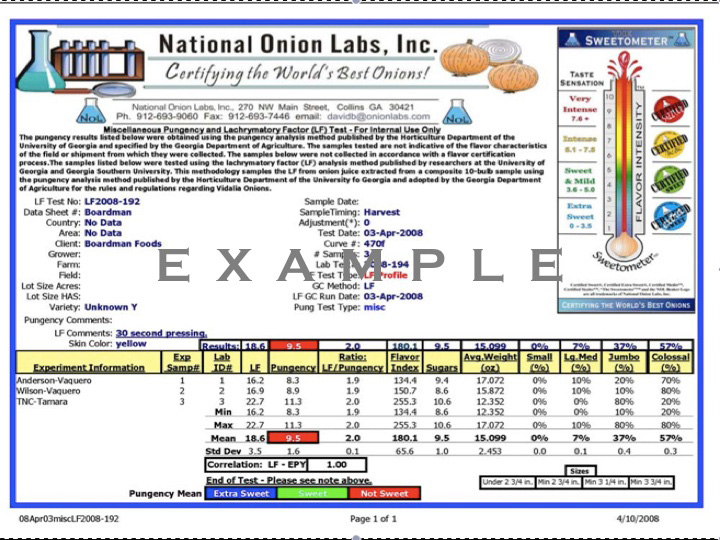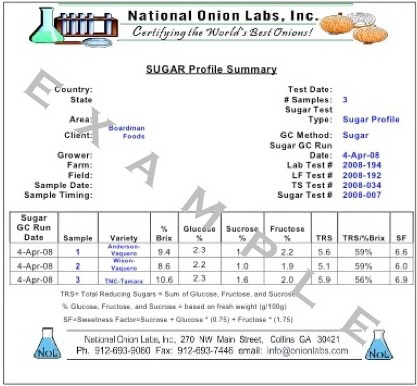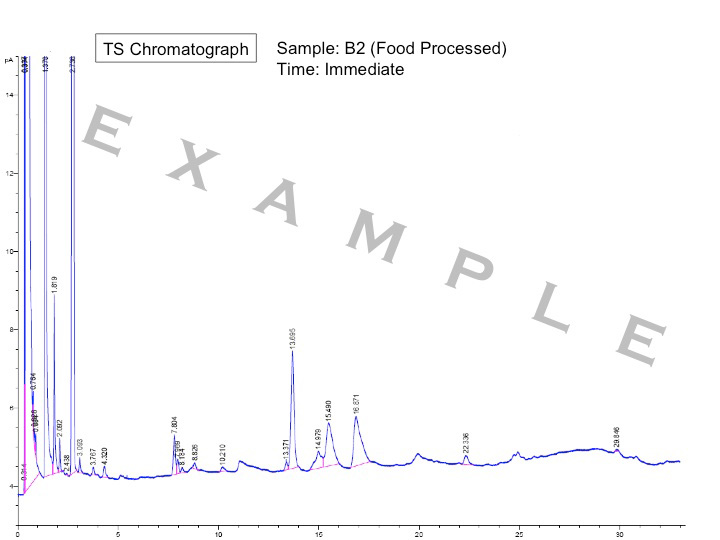Analytical Services
National Onion Labs Inc. owns and operates its own in-house flavor laboratory that provides our clients with timely chemical analyses and recommendations based on those results. We use scientifically validated and consistent laboratory methodologies that enable our clients to come back year after year confident in the knowledge that they are receiving independent lab services from one of the Nation’s most reputable flavor labs.
Chemical Analyses NOL performs
 Pungency (also referred to as Pyruvate or Pyruvic Acid; PA) is the “standard” industry tool to evaluate an onions’ potential to be perceived as extra sweet, sweet, mild or hot. Onions testing with 5.0 µmoles/ml of PA or less have generally been regarded as sweet/mild and those testing above 5.0 µmoles/ml of PA are generally regarded as being pungent/hot. Within the “sweet/mild” group there are many gradients of flavor quality. The Pungency test measures Pyruvic Acid which indicates the quantity of the onion flavor compounds. The pungency test has limitations as some onions are reported as having low pungency, but do not taste sweet. In contrast, some varieties test with high pungency levels, yet the onions do not taste hot.
Pungency (also referred to as Pyruvate or Pyruvic Acid; PA) is the “standard” industry tool to evaluate an onions’ potential to be perceived as extra sweet, sweet, mild or hot. Onions testing with 5.0 µmoles/ml of PA or less have generally been regarded as sweet/mild and those testing above 5.0 µmoles/ml of PA are generally regarded as being pungent/hot. Within the “sweet/mild” group there are many gradients of flavor quality. The Pungency test measures Pyruvic Acid which indicates the quantity of the onion flavor compounds. The pungency test has limitations as some onions are reported as having low pungency, but do not taste sweet. In contrast, some varieties test with high pungency levels, yet the onions do not taste hot.
Lachrymatory Factor (LF) test is a direct chemical measurement of the sulfur volatile, Thiopropanal-S-oxide (also referred to as the Lachrymatory Factor). LF is the chemical compound which directly causes the eye to tear (often called the onion lachrymator) and the chemical sensation of heat or mouth burn when an onion is eaten. It is measured using HPGC equipment and is reported in µmoles of LF/ml of onion juice. Whilst very limited taste panel work has been done with LF (due to its highly volatile nature) one can establish some general guidelines from traditional Granex products where LF at harvest is generally 1.1 to 1.2 times the pungency results. With a maximum PA level of 5.0 and a maximum LF to Pyruvate ratio of 1.4 to 1.0 (which is frequently encountered with stored Vidalia® types), a maximum LF tolerance of around 7.0 can be interpolated.
 Sweetness (also includes % Brix, total soluble solids, sucrose, glucose and fructose content) is the typical method for measuring and reporting sweetness in fruit. The higher the brix level of your fruit, the higher the dissolved solids in the food such as sucrose, glucose, fructose, PLUS vitamins, minerals, amino acids, proteins, hormones and all the other goodness that the plant puts into the food. It is estimated that in a healthy fruit or vegetable, approximately 80% of the brix is represented by the natural sugars which give the food its great flavor and goodness. It is believed by many people to be the best indicator of quality available in one quick and simple test. The Full Sugar Profile identifies and establishes Total Sugars which is the sum of Glucose, Sucrose and Fructose. Glucose is generally regarded as 60% of the sweetness of Sucrose (sugar), whereas Fructose is generally regarded as 60% sweeter than sugar. Sweetness Factor {= Sucrose + Glucose*(0.75) + Fructose*(1.75)} is calculated to account for these variable contributions to sweetness. We now know that humans detect fructose more easily and associate this compound with perceived sweetness, so for a true indicator of consumer experience, NOL encourages clients to undertake the full sugar profile test.
Sweetness (also includes % Brix, total soluble solids, sucrose, glucose and fructose content) is the typical method for measuring and reporting sweetness in fruit. The higher the brix level of your fruit, the higher the dissolved solids in the food such as sucrose, glucose, fructose, PLUS vitamins, minerals, amino acids, proteins, hormones and all the other goodness that the plant puts into the food. It is estimated that in a healthy fruit or vegetable, approximately 80% of the brix is represented by the natural sugars which give the food its great flavor and goodness. It is believed by many people to be the best indicator of quality available in one quick and simple test. The Full Sugar Profile identifies and establishes Total Sugars which is the sum of Glucose, Sucrose and Fructose. Glucose is generally regarded as 60% of the sweetness of Sucrose (sugar), whereas Fructose is generally regarded as 60% sweeter than sugar. Sweetness Factor {= Sucrose + Glucose*(0.75) + Fructose*(1.75)} is calculated to account for these variable contributions to sweetness. We now know that humans detect fructose more easily and associate this compound with perceived sweetness, so for a true indicator of consumer experience, NOL encourages clients to undertake the full sugar profile test.
 Thiosulfinate Profile Test (TSP), in conjunction with the Pyruvic Acid (PA), Lachrymatory Factor (LF) and % Brix tests, provides the most comprehensive flavor analysis of an onion sample currently available. Thiosulfinate compounds are responsible for the majority of both pleasant and undesirable onion flavors released when an onions is cut, cooked and consumed. These flavors are ‘sulfur-based’ compounds known to be present in all onions, but in varying amounts (concentration). It is a direct chemical measurement of the sulfur volatile reactions which occur when onion tissue is crushed. In brief, when the tissue is crushed the alliinase enzyme (in the cell vacuole) comes into contact with the flavor precursors (in the cell cytoplasm.) Their formation and metabolism are independent of PA, LF and sugar levels, however evidence suggests that the interactions between these compounds contributes significantly to a consumer’s overall taste experience. This test is designed to provide further insight and knowledge of the full onion flavor profile contained within this sample that may impact on the final taste experience.
Thiosulfinate Profile Test (TSP), in conjunction with the Pyruvic Acid (PA), Lachrymatory Factor (LF) and % Brix tests, provides the most comprehensive flavor analysis of an onion sample currently available. Thiosulfinate compounds are responsible for the majority of both pleasant and undesirable onion flavors released when an onions is cut, cooked and consumed. These flavors are ‘sulfur-based’ compounds known to be present in all onions, but in varying amounts (concentration). It is a direct chemical measurement of the sulfur volatile reactions which occur when onion tissue is crushed. In brief, when the tissue is crushed the alliinase enzyme (in the cell vacuole) comes into contact with the flavor precursors (in the cell cytoplasm.) Their formation and metabolism are independent of PA, LF and sugar levels, however evidence suggests that the interactions between these compounds contributes significantly to a consumer’s overall taste experience. This test is designed to provide further insight and knowledge of the full onion flavor profile contained within this sample that may impact on the final taste experience.
Texture Analyses
NOL can perform texture assessments on fresh and processed produce. Tension, juiciness and hardness are all measurable characteristics that we are able to assist in determining for the discerning client. Please contact NOL directly for more information.
Consumer Taste Assessments
NOL can perform small scale (up to 12 consumers) taste assessments using everyday people or panellists accustomed to tasting panel procedures for our clients seeking answers to actual likely consumer responses. This is a confidential service that is typically useful to seed breeders, marketers and retailers. NOL is uniquely equipped to perform these taste assessments with simultaneous chemical analyses.
Physical Assessments NOL Performs
All samples received at NOL’s flavor laboratory are weighed and sized according to industry standards. These results are provided to clients with all chemical analyses undertaken. This data can assist in overall understanding of the impact of yield and flavour profiles.
Sending Samples
National Onion Labs, Inc. has numerous import permits that enables clients from all over the world to send Allium spp. (mainly onion, garlic and leek) samples directly to our US based flavor laboratory. To see if NOL has an up-to-date import permit that caters to your country of origin please visit (insert pdf link to form). To request NOL obtaining an import permit please email labresults@onionlabs.com or call us.
All samples sent to NOL must include the following two forms fully completed:
a) NOL- Client Information Form* .NOL – Client Information Form
b) NOL-Client Sample Submission Form* NOL – Client Sample Submission Form
*These forms must be faxed/pdf’d to NOL prior to sending the samples (so we can ensure staff are looking out for your samples and are available to assess your samples) fax/email information is located on the forms
All samples must be sent to NOL at:
National Onion Labs, Inc.
270 NW Main Street
Collins, GA, 30421, USA
Samples should be sent in bags or containers that allow the samples to respire naturally (in order to reduce the accumulation of moisture) and to protect them from bruising. Do not use plastic bags under any circumstances as this restricts respiration sometimes resulting in increased stress in the plant products which can affect the subsequent chemical analyses, as well as encouraging the onset of disease and rots. Samples should be sent via a delivery or postal service that will ensure the produce is in transit for no longer than 5 to 7 days.
See Crop Services and Certification Services